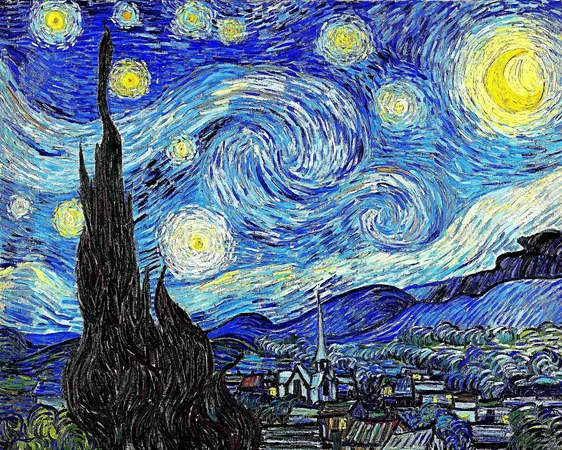
Dissecting 'The Starry Night': Is Van Gogh's Masterpiece Really a Chaos in Motion?
2025-04-01
Author: Siti
Introduction
In a surprising twist for art enthusiasts and physicists alike, researchers from Virginia Commonwealth University and the University of Washington have challenged a popular recent theory regarding Vincent van Gogh's iconic painting, 'The Starry Night'. While undoubtedly one of the most celebrated works in Western art—a breathtaking swirl of blues and vibrant yellows capturing the pre-sunrise sky and a quaint village—the painting may not be the masterpiece of fluid dynamics that some have claimed.
About the Painting
Painted in June 1889 during Van Gogh's time in an asylum in southern France, 'The Starry Night' is known for its emotionally charged depiction of the night sky, showcasing swirling forms that let viewers interpret a world beyond the visible. The artwork is housed in the prestigious Museum of Modern Art in New York City, where it continues to captivate millions.
Recent Controversy
Interest in the painting surged last year, particularly after a study in the September edition of Physics of Fluids. This publication suggested that the dynamics of Van Gogh's swirls could actually reflect Kolmogorov's theory of turbulence, a scientific principle used to explain the chaotic movement of air and water. Researchers claimed that Van Gogh had artistically captured the scale, distance, and intensity of turbulence in his strokes.
Expert Opinions
However, according to Dr. Mohamed Gad-el-Hak and Dr. James J. Riley—both experts in mechanical engineering and turbulence—the conclusions drawn in that study were unfounded. Their work, recently published in the Journal of Turbulence, disputes the initial assertions, highlighting a misapplication of Kolmogorov's principles.
Dr. Gad-el-Hak notes that while Kolmogorov's theories have significantly shaped the field of turbulence research, they are primarily applicable to fluid velocity fields, not the artistic nuances of paint on canvas. "There is no identifiable, measurable scalar fluid property in the painting that could justify applying the turbulence theory, as the initial study suggested," Riley explained. "Moreover, the atmospheric conditions inferred do not meet the necessary criteria for this theory."
Conclusion
The debate over Van Gogh's swirling masterpiece raises intriguing questions about the intersection of art and science. Could there be hidden meanings and scientific principles encapsulated within famous artworks? Or, perhaps, does that desire to find scientific order in artistic chaos overlook the emotional intent behind a brushstroke?
As art continues to inspire inquiry across various disciplines, one thing remains clear: Van Gogh’s 'The Starry Night' is more than just a reflection of physical laws; it's a human expression of feelings and emotions swirling in the cosmic void—a true masterpiece in its own right. Whether or not it adheres to the laws of turbulence, it still captivates minds and hearts alike, reminding us that not all beauty can be computed.
Stay tuned as we continue to explore intersections of art, science, and the curious human mind!





 Brasil (PT)
Brasil (PT)
 Canada (EN)
Canada (EN)
 Chile (ES)
Chile (ES)
 Česko (CS)
Česko (CS)
 대한민국 (KO)
대한민국 (KO)
 España (ES)
España (ES)
 France (FR)
France (FR)
 Hong Kong (EN)
Hong Kong (EN)
 Italia (IT)
Italia (IT)
 日本 (JA)
日本 (JA)
 Magyarország (HU)
Magyarország (HU)
 Norge (NO)
Norge (NO)
 Polska (PL)
Polska (PL)
 Schweiz (DE)
Schweiz (DE)
 Singapore (EN)
Singapore (EN)
 Sverige (SV)
Sverige (SV)
 Suomi (FI)
Suomi (FI)
 Türkiye (TR)
Türkiye (TR)
 الإمارات العربية المتحدة (AR)
الإمارات العربية المتحدة (AR)